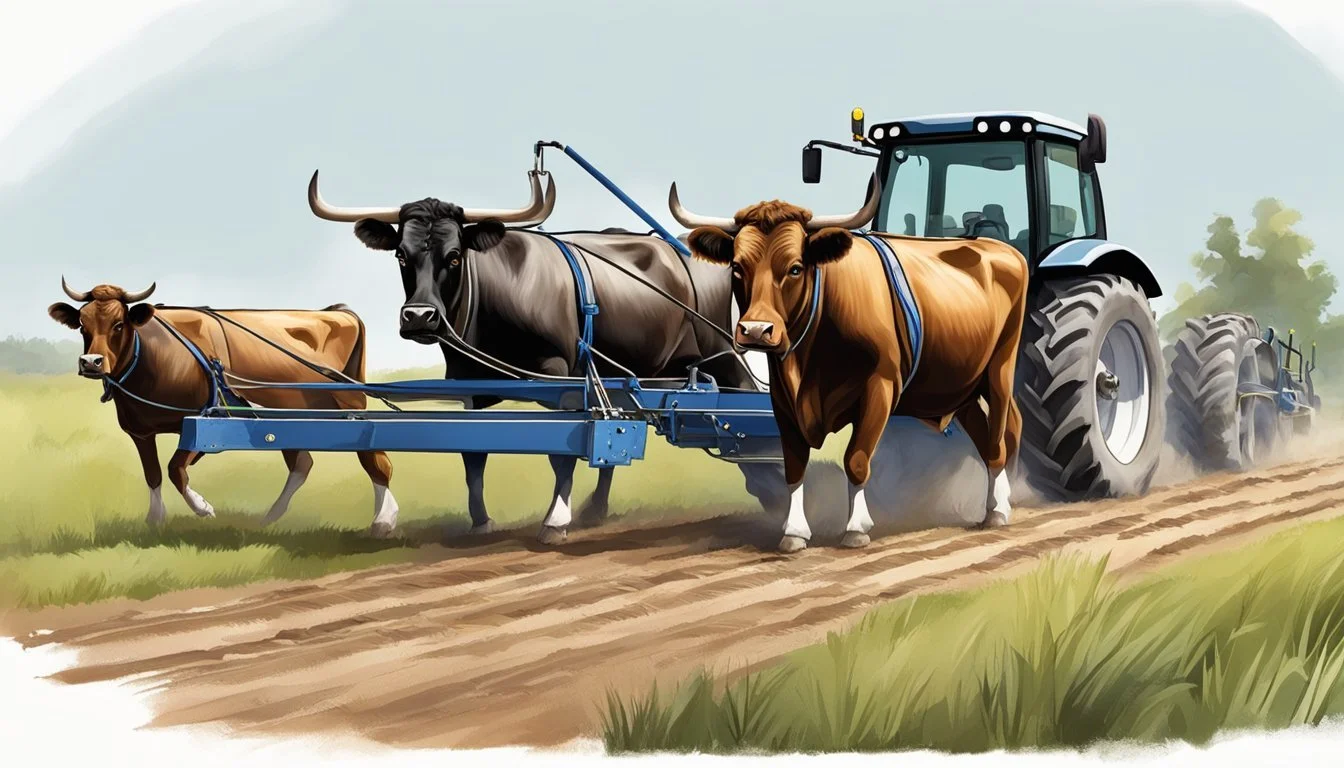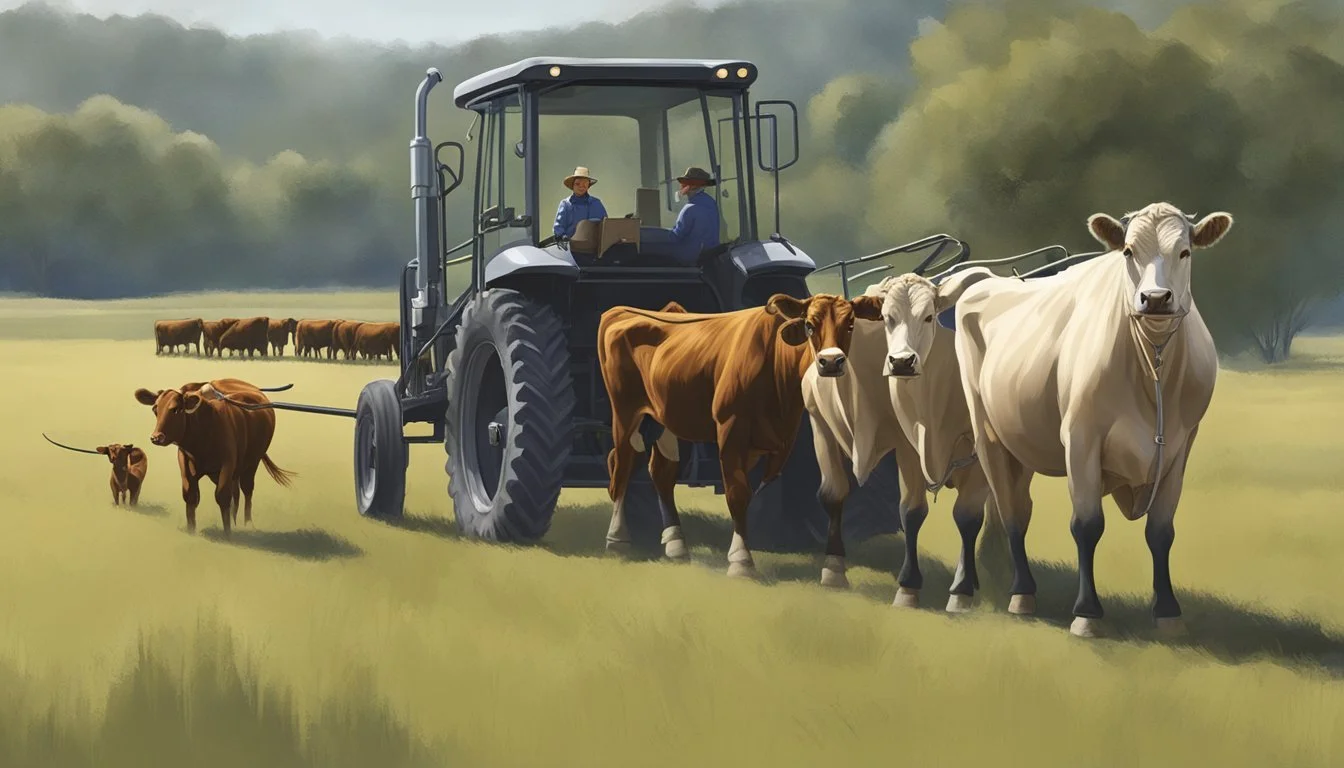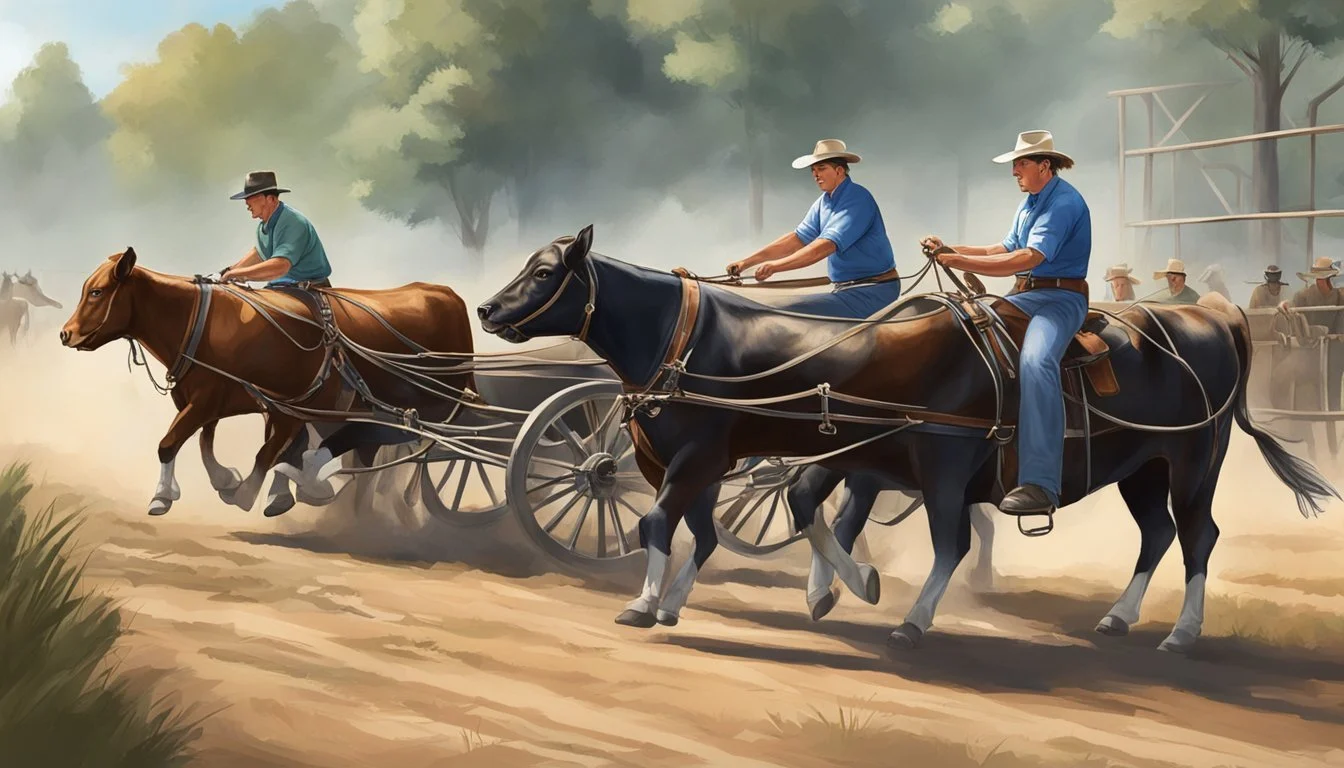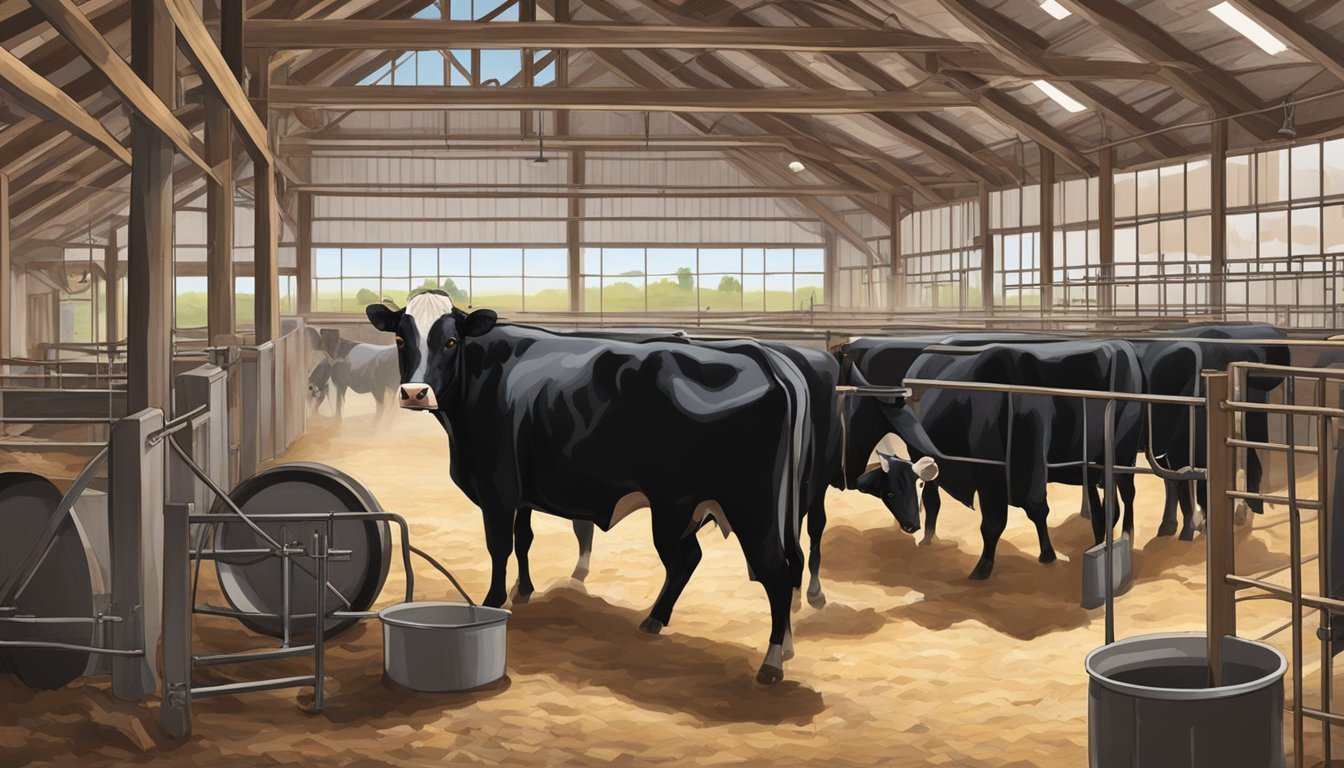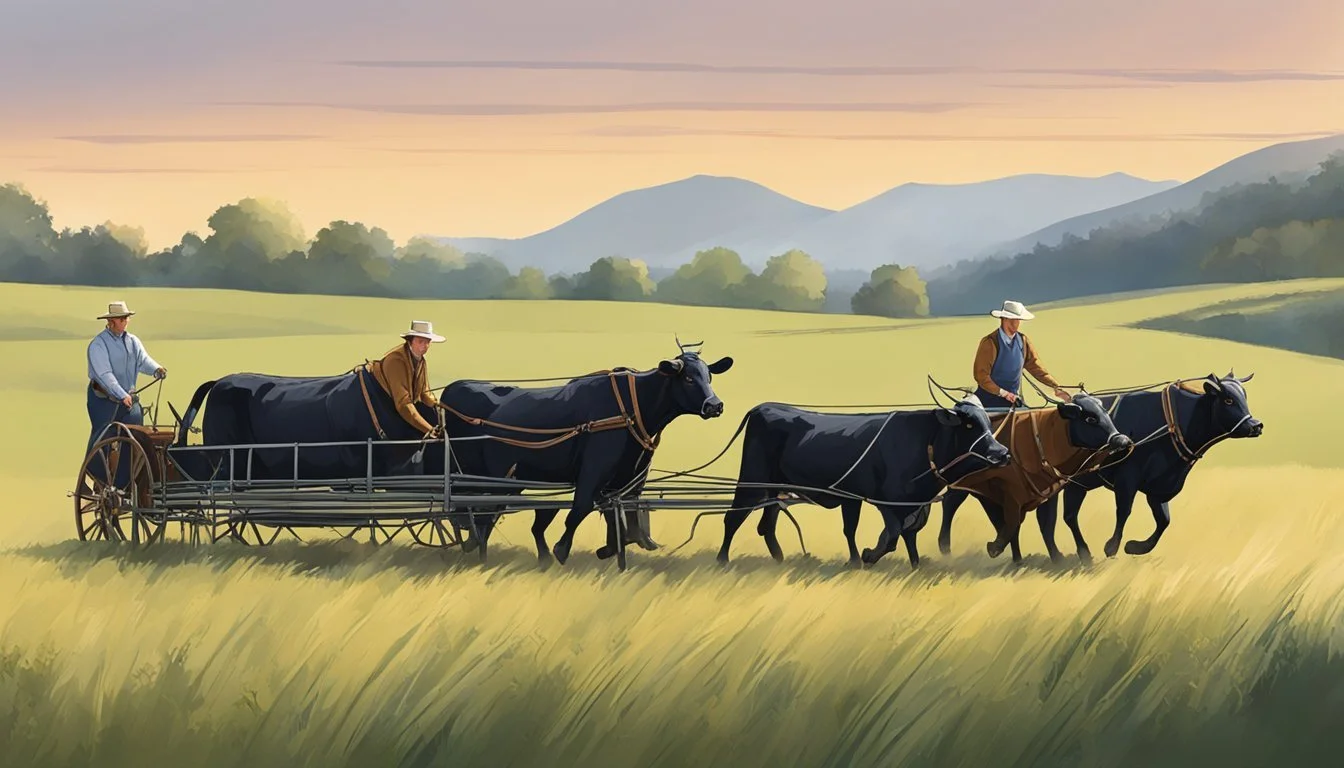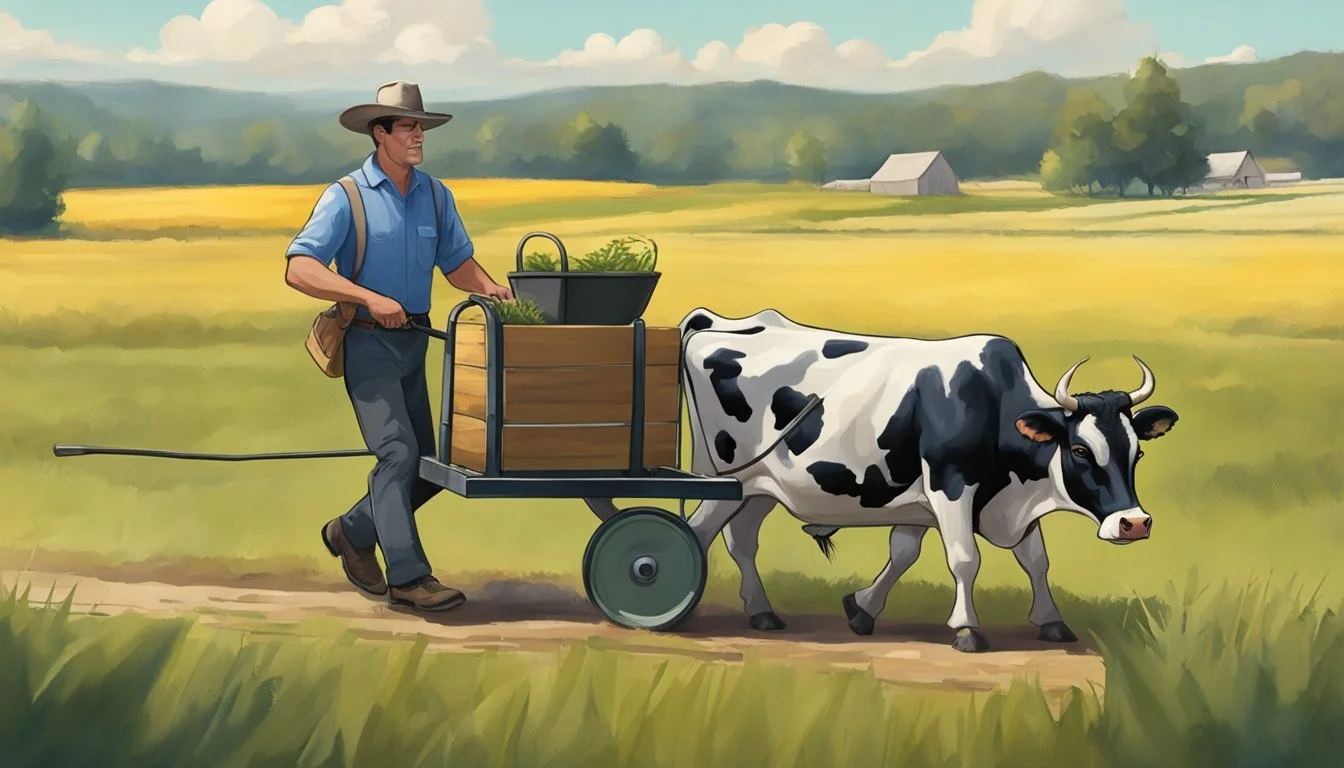How to Train Dexter Cattle for Harness and Draft Work
A Step-by-Step Guide
Dexter cattle, a versatile and docile breed, are increasing in popularity among small-scale farmers and homesteaders for their capacity to perform in various roles, including harness and draft work. This smaller breed of cattle is particularly well-suited for such tasks due to their strength and manageable size, making them ideal for non-industrial farm operations, parades, and educational programs like 4H. Training Dexter cattle for harness and draft can be a rewarding endeavor, providing a sustainable means of energy for farm work while also nurturing a unique bond between the animals and their handlers.
The process of training Dexter cattle for harness and draft involves patience, consistency, and a progressive approach to handling the animals. Starting at a young age, calves can be accustomed to human interaction, which lays the foundation for further training. Introducing them to wearing a halter is a key step, ensuring they become comfortable with the gear they will don for work. Unlike larger cattle breeds, Dexters are known for their even temperament, which can significantly ease the training process. Their energy efficiency and growing popularity underscore their potential as a 'recovering' breed that can contribute significantly to the sustainable practices on a small-scale farm.
Harness and draft work is viable for Dexters, which are proportionally fleshy and yield a higher percentage of meat than some dairy breeds, indicating their strength and muscle development ideal for draft purposes. The training not only promotes the utility of these animals on the farm but also showcases the multifaceted nature of Dexter cattle, which are already esteemed for milk and meat production. With the right guidance, Dexter cattle can become reliable partners in draft work, reflecting a thriving dynamic between the animals and their homestead environment.
Understanding Dexter Cattle
Before domesticating Dexter cattle for harness and draft work, it is essential to grasp their historical background, distinctive physical attributes, and behavioral tendencies.
History and Origin
Dexter cattle trace their lineage to southwestern Ireland, where they were bred by small landholders. Recognized as a heritage breed, they were imported to North America in the early 20th century, and organizations like the American Dexter Cattle Association keep meticulous records to preserve their lineage. Unlike many common breeds, Dexters are considered rare and have a long history of adaptation, making them a robust option for various agricultural needs, including draft work.
Physical Characteristics
Dexter cattle are renowned for their compact size, measuring significantly shorter in stature than most other cattle breeds. Mature bulls stand about 38 to 44 inches at the shoulder, while cows range from 36 to 42 inches. They exhibit solid colors typically in black, red, or dun with occasional white markings, discouraged if extensive. The Dexter breed standard allows for both horned and polled (naturally hornless) individuals. Horns, when present, are medium in size and curve slightly upwards. A genetic disorder known as chondrodysplasia, or dwarfism, may occur in this breed, but careful breeding practices work to minimize its prevalence.
Size: Bulls: 38-44 inches at shoulder, Cows: 36-42 inches at shoulder
Color: Primary - Black, Red, Dun; Secondary - White markings (limited)
Horns: Present in some, moderate thickness with upward curve
Chondrodysplasia: Genetic condition present in some Dexters
Temperament and Behavior
Dexter cattle are prized for their gentle and amiable temperament, making them a favorable breed for small landholders and homesteaders. This breed's hardiness and versatility lend it to adapt well to various climates and work situations. Their behavior is generally docile, cooperative, and manageable, traits that are particularly advantageous for training in harness and draft tasks. The breed's size makes them less intimidating and easier to handle than larger draft animals, which is often appreciated by those with smaller land areas or less experience in cattle handling.
Dexter Cattle as Draft Animals
Dexter cattle provide a compact, versatile option for draft work, being energy-efficient and suitable for various tasks on a homestead.
Advantages of Dexter Cattle for Draft Work
Dexter cattle offer several benefits for draft and harness purposes. Their compact size makes them easier to handle than larger draft animals, such as horses or traditional oxen. Homesteaders find their size advantageous, especially when working in confined spaces where larger equipment like tractors cannot maneuver. Moreover, Dexter cattle are energy-efficient, requiring less feed compared to larger breeds while still delivering sufficient power for pulling and other chores. They also display a tender disposition, which translates to ease of handling and a lower risk of injury for both the cattle and the handler. This docility is particularly valuable for tasks that require consistent, calm behavior over long periods.
Training Basics for Draft and Harness
Training a Dexter for draft work begins with basic commands and handling to foster trust and response to a halter and rope. The training process should be gradual, starting with simple commands such as "stand," "walk," and "stop." Consistency is key in reinforcing these commands. As they grow accustomed to the halter, introduce light objects they can drag without resistance. Positive reinforcement aids in creating a stress-free environment for learning. It's essential to remember that patience is crucial, as Dexters are intelligent and capable but require clear, repetitive instruction to excel in their roles as draft animals.
Harnessing and Equipment Basics
Proper harnessing and equipment are essential for the safety and comfort of Dexter cattle engaged in draft work. The harness should fit snugly to distribute the load evenly without causing discomfort. Starting with a simple yoke or harness system allows the Dexter to become familiar with the sensation of carrying weight. Over time, you can introduce more complex harnesses suited for various tasks. When selecting equipment, durability and adjustability are vital factors. It ensures that the Dexters can work efficiently, whether they're pulling logs, plows, or participating in parades. It's also crucial for handlers to be familiar with the proper method of attaching and balancing loads to prevent injury and maximize the power of the Dexter cattle.
Feeding and Nutrition
Proper feeding and nutrition are crucial for training Dexter cattle for harness and draft work. This ensures they develop the strength and endurance needed for the tasks they will perform.
Grass-fed vs Grain-fed
Dexter cattle can be either grass-fed or grain-fed, with each method having implications for their growth and suitability for draft work. Grass-fed Dexters graze on pasture, which requires ample land for rotational grazing to prevent overgrazing and maintain a high-quality diet. The benefit of a grass-fed diet lies in its impact on the cattle's health and the quality of dairy products, which often have a high butterfat content desirable for dairy production.
In contrast, grain-fed Dexters are often given a diet that includes grains to increase their energy density. Farmers may choose to supplement with grain to promote faster growth and increase muscle development, which can be beneficial for draft purposes. However, it's important to balance grain feeding to avoid health issues and ensure a proper nutrient intake.
Daily Diet Requirements
A balanced diet for Dexter cattle in training should include:
Roughage: Hay or pasture for constant grazing, ensuring ongoing fiber intake.
Grain: In moderation, to provide energy for muscle development.
Protein: Essential for muscle growth and repair; may come from both pasture and supplements.
Minerals: Such as calcium and phosphorus, which are critical for bone health and overall well-being.
Water: Approximately 5 to 15 gallons per day, depending on activity level and environmental conditions.
Here is a simplified daily diet breakdown for an average Dexter being trained for harness and draft work:
Nutrient: Roughage, Requirement (Adult Dexter): Free access to quality grass/hay
Nutrient: Grain, Requirement (Adult Dexter): Up to 2 lbs per day (if needed)
Nutrient: Protein, Requirement (Adult Dexter): 7-12% of total diet
Nutrient: Minerals, Requirement (Adult Dexter): Supplement as per veterinary advice
Nutrient: Water, Requirement (Adult Dexter): 5-15 gallons per day (based on workload)
Farmers must pay careful attention to the dietary needs of their Dexter cattle, adapting them to the animal's workload and physiological requirements. Regular consultation with a veterinarian or a cattle nutritionist is recommended to tailor the diet for optimal performance in harness and draft activities.
Health and Well-being
Maintaining the health and well-being of Dexter cattle is crucial for their ability to perform harness and draft work. These cattle require routine veterinary care, balanced nutrition, and suitable housing to ensure their longevity and productivity. Recognizing and addressing common health issues is also an imperative part of their care.
Routine Veterinary Care
Vaccinations: Dexter cattle should follow a vaccination schedule as advised by a veterinarian to prevent common infectious diseases.
Parasite Control: Regular deworming helps prevent parasitic infections which can affect overall health and work performance.
Hoof Care: Periodic hoof trimming prevents foot problems, aiding in comfort during draft work.
Dental Check-ups: Annual dental examinations ensure that teeth issues do not affect feeding and nutrition.
Shelter and housing play a vital role in the well-being of Dexter cattle, especially for those involved in harness and draft work. They should have access to clean, dry bedding and protection from extreme weather conditions.
Common Health Issues in Dexter Cattle
Dexter cattle may encounter several health concerns that owners should be vigilant about:
Respiratory Infections: Often related to poor ventilation in housing, these can impact their stamina and ability to work.
Musculoskeletal Injuries: Due to the physical nature of draft work, injuries like sprains or strains are possible. Quality nutrition and proper workload management can mitigate these risks.
Digestive Troubles: Feeding protocols must ensure a balanced diet to avoid issues such as bloat or acidosis.
Calving Complications: While Dexter cattle generally have easier calving experiences, monitoring during the breeding season is essential to address any potential calving difficulties quickly.
By emphasizing these health and well-being aspects, Dexter cattle can live a full lifespan and serve effectively in harness and draft roles.
Reproductive Management
Effective reproductive management is crucial for training Dexter cattle for harness and draft work, as it ensures a steady supply of well-adjusted and healthy calves. The focus lies in timing the breeding to align with training schedules and maintaining the lifespan and productivity of the cattle.
Breeding Planning
Breeding Timeframe: Dexter cattle have an average gestation period of approximately 283 days. Owners should aim for breeding that optimizes the calving season to fit with training routines. Examples include avoiding peak manual labor periods or harsh weather conditions that can impact both the dam and the calf's health.
Breeding Season: Spring, Expected Calving Season: Late Winter/Early Spring
Breeding Season: Autumn, Expected Calving Season: Summer
Health and Longevity: It's imperative to select both sires and dams with desirable traits such as temperament, physical conformation, and longevity. This reinforces the quality and capabilities of the draft animals over their lifespan.
Calf Rearing
Post-Calving Care: Monitoring is essential in the first hours after calving to ensure the calf receives adequate colostrum, which is vital for immunity. The calves should be introduced to harness training gradually, once they've reached an appropriate age and size, ensuring a positive start to their training lifecycle.
Growth and Development: A calf’s early development is critical. A balanced diet and proper husbandry practices contribute to a robust framework and strength—qualities necessary for their future role in harness and draft work. Regular health checks and a stable environment promote calves’ well-being and longevity.
Milk and Meat Production
Dexter cattle are a dual-purpose breed, efficient in producing both rich milk and flavorful beef. They are highly valued by homesteaders and small ranches for their adaptability and efficient feed conversion.
Dexter Cattle for Dairy
Dexter cows provide milk with a high butterfat content, making it ideal for dairy products like cheese and butter. Milk production typically ranges from 1.5 to 2.5 gallons per day, which is more than sufficient for most family homesteads. Due to their smaller size, they consume less feed compared to larger dairy breeds, making them economical for dairy operations focused on quality over quantity.
Key Dairy Aspects:
Milk Output: 1.5 to 2.5 gallons/day
Butterfat Content: High, enriches dairy products
Raising Dexter Cattle for Beef
The beef from Dexter cattle is known for its good marbling and taste, which is often compared favorably to more widely-known breeds like Hereford and Angus. Dexter beef finds a niche market among consumers who appreciate its flavor and quality. These cattle can be raised exclusively on pasture, with the option of grain supplementation, allowing for flexible feeding regimes that can influence marbling and overall meat quality.
Beef Characteristics:
Flavor: Rich, with a reputation for being particularly tender and flavorful
Marbling: Good marbling, contributes to the taste and texture of the meat
Market Position: Niche, appealing to consumers seeking quality and sustainably raised beef
Breeding and Genetics
When training Dexter cattle for harness and draft work, understanding and applying principles of breeding and genetics are foundational to developing a strong and capable animal. Selective breeding strategies enhance the hardiness and desired characteristics essential for a tri-purpose breed like the Dexter, which are valued by homesteaders for their versatility.
Understanding Dexter Cattle Genetics
Dexter cattle possess a unique genetic makeup that contributes to their status as a tri-purpose breed, valued for milk, meat, and draft capabilities. Breeders must comprehend the genetic factors influencing traits such as the breed's notable hardiness, which allows them to adapt to various climates and conditions, critical for any draft animal. Homesteaders often prefer the Dexter breed for its manageable size and natural ability to thrive on pasture.
To maintain genetic diversity within the breed, it is important to ensure a broad genetic pool when selecting breeding stock. Dexter cattle can be horned or polled (naturally hornless), and the decision to select for horned or polled genetics can be a consideration for breeders; dehorning can be avoided by selecting for polled genetics. However, whether horned or polled, the focus should remain on the breed's overall robustness.
Breeding for Desired Traits
Breeding for desired traits in Dexter cattle, such as temperament and physical conformation suitable for harness and draft work, requires careful pairing of breeding stock. Here is an approach for breeding Dexters for draft:
Evaluate Conformation: Select individuals with strong, muscular builds and solid legs to support harness work.
Temperament Testing: Choose cattle with calm demeanors, critical for training in draft situations.
Health Screening: Utilize genetic testing to identify and exclude hereditary conditions that could affect work capability.
Record Keeping: Maintain detailed records of lineage and traits to guide future breeding decisions and maintain genetic diversity.
Breeders should aim to produce well-rounded, fit animals that exhibit the best characteristics of the breed while carefully managing inbreeding to prevent genetic disorders. Utilizing genetic tests, such as those offered by specialized labs, can help identify beneficial traits and avoid genetic defects. By focusing on these principles, breeders can successfully contribute to the pool of Dexter cattle that are not only genetically sound but also excel in harness and draft work.
Farm Management and Equipment
Proper management of the farm and selection of the right equipment are crucial factors in training Dexter cattle for harness and draft work. They ensure safety and efficiency in working with these versatile animals.
Housing and Fencing
Dexter cattle require adequate shelter that provides protection from extreme weather conditions. Open-sided sheds or barns allow for ventilation while offering protection from wind, rain, and ice. For fencing, sturdy materials that prevent escape or injury are essential. Electric fencing is often used for its effectiveness and affordability.
Type of Shelter: Open-sided shed or barn
Fencing: Electric, wooden, or metal rail fencing
Handling Facilities and Equipment
When dealing with draft animals, secure handling facilities and appropriate equipment are a must. Handling facilities should include a squeeze chute and headgate to safely restrain cattle during training. As for equipment, a well-fitted yoke or harness is essential for connection to a plow or load. Training equipment should be adjustable and comfortable for the animal to prevent strain or injury.
Handling Facility Components:
Squeeze chute
Headgate
Draft Equipment:
Yokes
Harnesses
Choosing the right equipment can make a significant difference in training success, as Dexters are smaller than typical draft breeds and unique tools may be required. Moreover, training equipment often serves as an alternative or supplement to tractors, especially where land conservation practices align with the Livestock Conservancy's recommendations for heritage breeds like Dexter cattle. It is important to ensure that all equipment, including that used for housing and containment, is in good working order to maintain a safe environment for both humans and animals.
Marketing and Economics
In harness and draft work, Dexter cattle offer a unique niche market opportunity. Their economical advantages stem from their adaptability and efficient grazing habits.
Understanding the Market
The market for Dexter cattle trained for harness and draft work is specialized. These cattle are sought after by small-scale farmers and homesteaders who require animals that can perform various farm tasks. Dexter cattle are known for their adaptability to different work environments, making them suitable for a range of farm duties, including plowing and pulling carts.
Key Market Considerations:
Demand: Identify areas with a demand for draft animals; small-scale farms often prefer the manageable size of Dexter cattle.
Competitive Edge: Dexter cattle's versatility in both meat and draft work can set them apart in the market.
Marketing Channels: Direct sales to farmers, online advertising on agricultural platforms, and participation in local farm shows are effective strategies.
Economical Advantages of Raising Dexter Cattle
Dexter cattle represent an economical choice for farmers interested in harness and draft work due to their productivity and low maintenance. They are efficient grazers and can thrive on pasture-based diets, which can reduce feed costs. Their smaller size compared to traditional draft breeds means they require less space and food, further lowering expenses.
Economical Benefits:
Feed Efficiency: Their ability to graze efficiently makes them less costly to feed than larger cattle breeds.
Dual-Purpose: As a dual-purpose breed, they provide both labor and meat, optimizing economic return on investment.
Homesteading Appeal: The breed's manageability and docility make them ideal for homesteads, attracting a specific customer base dedicated to sustainable living.
By understanding the market and leveraging the economical advantages of raising Dexter cattle, farmers can establish a profitable niche in harness and draft work.


